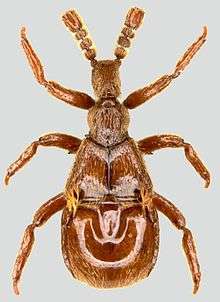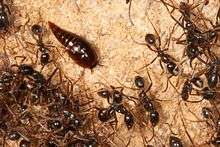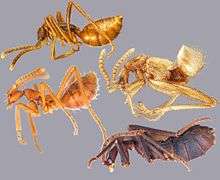Myrmecophily in Staphylinidae

Many species of Staphylinidae (commonly known as “Rove Beetles”) have developed complex interspecies relationships with ants, known as myrmecophily. Rove Beetles are among the most rich and diverse families of myrmecophilous beetles, with a wide variety of relationships with ants. Ant associations range from near free-living species which prey only on ants, to obligate inquilines of ants, which exhibit extreme morphological and chemical adaptations to the harsh environments of ant nests. Some species are fully integrated into the host colony, and are cleaned and fed by ants. Many of these, including species in tribe Clavigerini, are myrmecophagous, placating their hosts with glandular secretions while eating the brood[1]
Taxonomy
Staphylinidae is currently considered to be the largest family of beetles, with over 58,000 species described. As such, many myrmecophilous species are unknown. The majority of studied myrmecophilous Rove Beetles belong to the subfamily Aleocharinae, including the commonly studied genera Pella, Dinarda, Tetradonia, Ecitomorpha, Ecitophya, Atemeles, and Limechusa, and to the subfamily Pselaphinae, which includes Claviger and Adranes. There are also representatives of Scydmaenidae, which includes 117 myrmecophilous species in 20 genera[2] The Aleocharinae possess defensive glands on their abdomens, which are used in myrmecophilous species to prevent attacks by their host ant and in more extreme cases to integrate completely into the colony. Many Pselephinae species have trichomes, tufts of hairs which hold placating pheromones. Pselephines have evolved trichomes independently at least four times, most notably in all members of Clavigerini, but also in Attapsenius and Songius genera.[3]
Ecology and Behavior
Due to their large number and diversity, myrmecophilous Rove Beetles occupy an array of behaviors. Myrmecophilous interactions can be generalized into categories, in three of which Staphylinids can be found. The synecthrans, or “persecuted guests,” the synoeketes, or “tolerated guests,” and the symphiles, or “true guests.”[4]
Synecthrans
Synecthran Staphylinids live on the periphery of the host colony and are not accepted into the colony. The majority are in the subfamily Aleocharinae, having defensive glands on their terminal abdominal segments. Species in this group, such as those in the genus Pella, commonly lay their eggs in the refuse heaps of their host ant, where the larvae feed on the discarded carcasses of ants. If detected by the host ant, the larvae enters a typical defense position, facing the ant with its abdomen tip raised. Usually this behavior results in the ant palpating the beetle’s abdomen and stopping the attack.[5] At least two members of Pella, P. funestus and P. humeralis, produce several of their host ant’s alarm pheromones to avoid aggression.[6] Other species, like members of Myrmechusa, Aenictonia, and Anommatochara, prey on raiding columns or on the nests of Driver ants (Dorylus).[7] Myrmechusa species attack the ants from the rear before pulling them from the main column. If pursued, they rapidly wave their abdomens through the air, releasing a noticeable scent. Ants encountering this scent seem disoriented and take almost 20 minutes to recover.[8]
Synoeketes

Synoeketetic Staphylinids live in close contact with their host ants but are not integrated into the colony. These species may be further categorized as neutral, mimetic, loricate, and symphiloid synoeketes. Neutral synoeketes ignore and are ignored by their host, but feed on refuse. There are few Staphylinid neutral synoeketes, but some are found in the genus Athetini, which live in the debris and fungal chambers of leaf cutter ants (Atta).[7] Mimetic synoeketes are myrmecoid, resembling their host ant morphologically. Many mimetic species are guests of Driver ants, which are blind. Driver ants however have strong senses of touch, suggesting mimics fool their hosts tactilely. It is also possible that mimicry may reduce predation from more visual animals, such as birds. Loricate, or “tear-drop shaped”, synoeketes are “defensive forms”. They typically exhibit long tapering bodies with broad thoraxes and smooth bodies, which prevent aggressing ants from gripping them. Symphiloids strongly resemble “true guests,” but are not fully integrated into the colony. They are often mimics, and in some species have developed trichomes.[9] Syneoketes generally live on or inside of ant nests, where they feed on refuse and may steal food from their hosts. There is some overlap between synoeketes and other categories, especially in loricate species and synecthrans, and symphiloids and symphiles, where the behavior of “true guests” may be difficult to determine.
Symphiles

Symphilic Staphylinids have been fully integrated into the host ant’s society. Symphilic species have undergone complex morphological adaptations, many becoming myrmecoid. Most have developed trichomes, which secrete appeasement pheromones. The most extreme adaptations, found in members of tribe Clavigerini, include the reduction of mouthparts for trophallaxis and the fusing of many body and antennal segments. While most symphiles use antennal contact to stimulate food giving from their host, at least one member of Clavigerini, Claviger testaceus, secretes a chemical to induce regurgitation from its host ant Lasius flavus.[10] Symphiles typically take on many roles in the colony, raising young, feeding and grooming adults, and helping transport food and larvae. Many Staphylinids are capable of following ant pheromone trails, although they are not limited to following trails laid by their host ant. This allows symphiles of army ants to migrate with the colony.[11] Most species are trophallactic, being fed by other members of the colony. Almost all species have also been observed feeding on the brood, making them obligate parasites.
Chemical Mimicry
Chemical mimicry refers to the production of one species’ chemical signals by another species. Many myrmecophilous Staphylinids have evolved chemical mimicry to deter or placate ants. Synecthrans, as non tolarated guests, primarily produce defensive secretions. Pella species produce two compounds found in their host ant Lasius fuliginosus, undecane and sulcatone, which elicit aggressive and panic reactions respectively. Although it seems counterintuitive to release an aggressive alarm pheromone as a defense, the presence of sulcatone stops the aggression response to undecane. Ants exposed to the defensive secretion act less aggressively and avoid the odor.
For Staphylinids accepted into the host colony chemical mimicry is used more for camouflage. The majority of the chemical signals used are cuticular hydrocarbons, which are produced in the cuticle of the host ant at certain concentrations and are palpated to determine the identity of an ant. Species in close contact with their host ants are able to pick up the host’s hydrocarbons and imitate the ant’s hydrocarbon pattern, thus appearing in scent at least to be the same species as the host ant. As hydrocarbon patterns are specific to an individual colony, the Rove Beetles are generally restricted to one nest. The production of a new hydrocarbon pattern takes time, during which the beetle is vulnerable to detection and attack.[6] Some species, such as Zyras comes, produce volatile pheromones as well as cuticular hydrocarbons, which may provide it more protection than contact based pheromones while traveling with its host in foraging trails.[12]
See also
References
- ↑ Lapeva-Gjonova, Albena (April 2013). “Ant-Associated Beetle Fauna in Bulgaria: A Review and New Data”. Psyche (Cairo: Hindawi Pub. Co.) 2013: 1-14
- ↑ O'Keefe, Sean (2000). "Ant-Like Stone Beetles, Ants, and Their Associations (Coleoptera: Scydmaenidae; Hymenoptera: Formicidae; Isoptera)". ‘’J. N. Y. Entomol. Soc.’’ (NYC: N. Y. Entomol. Soc.) 108 (3/4): 273–303.
- ↑ Parker, Joe; Eldredge, Taro (10 Dec 2012), "The Bizarre, Beetle-Biased World of Social Insect Exploitation", ‘’Scientific American’’
- ↑ Mynhardt, Glené (2013). "Declassifying Myrmecophily in the Coleoptera to Promote the Study of Ant-Beetle Symbioses". ‘’Psyche’’ (Cairo: Hindawi pub co) 2013: 1–8.
- ↑ Holldobler, B.; Moglich, M.; Maschwitz, U. (1981). "Myrmecophilic Relationship Of Pella (coleoptera: Staphylinidae) To Lasius fuliginosus (hymenoptera: Formicidae)". Psyche(Cairo: Hindawi Pub Co.) 88: 347–374
- 1 2 Stoeffler, Michael; S. Maier, Tanja; Till, Tolasch; L. M. Steidle, Johannes (2007). "Foreign-language Skills in Rove-Beetles? Evidence for Chemical Mimicry of Ant Alarm Pheromones in Myrmecophilous Pella Beetles (Coleoptera: Staphylinidae)". ‘’J Chem Ecol’’ (NYC: Springer Pub) 33: 1382–1392
- ↑ . Koblick, Tonya; H. Kistner, David. "A Revision of the Species of the Genus Myrmechusa from Tropical Africa with Notes on Their Behavior and Their Relationship to the Pygostenini (Coleoptera: Staphylinidae)". “Ann. Entomol. Soc. Am” 58 (1): 28–44
- ↑ M. Wheeler, William (1960). ‘’Ants: Their Structure, Development, and Behavior.’’ 9. NYC: Columbia Univ Press.
- ↑ Cammaerts, R. (1992). "Stimuli inducing the regurgitation of the workers of Lasius flavus (Formicidae) upon the myrmecophilous beetle Claviger testaceus (Pselaphidae)". “Behavioural Processes” (ScienceDirect) 28 (1-2): 81–95
- ↑ W. Rettenmeyer, Carl; D. Akre, Roger (1968). "Trail-Following by Guests of Army Ants (Hymenoptera: Formicidae: Ecitonini)". J. Kans. Entomol. Soc. (Kans. Entomol. Soc.) 41 (2): 165–174
- ↑ Akino, Toshiharu (2002). "Chemical camouflage by myrmecophilous beetles Zyras comes (Coleoptera: Staphylinidae) and Diaritiger fossulatus (Coleoptera: Pselaphidae) to be integrated into the nest of Lasius fuliginosus (Hymenoptera: Formicidae)". Chemoecology (NYC: Springer pub) 12 (2): 83–89